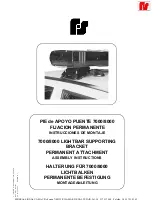
Driving on unpaved roads for long periods, or a sporty driving style, can temporarily
deactivate the Tyre Pressure Loss Indicator. The indicator lamp shows the malfunction, but
disappears if the road conditions or driving style change.
Troubleshooting for the Tyre Pressure Monitoring System
First read and observe the introductoryinformation and safety warnings
⇒
Introduction
Lit up
•
Do not drive on!
• Check all wheels for exterior damage or foreign bodies that have entered the tyres.
• Check the tyre pressure for all tyres
⇒
Tyre pressure
.
• Change the wheel or drive at a low speed to the nearest qualified workshop.
• Check and adjust the tyre pressure for all tyres
⇒
Tyre pressure
.
• Change the wheel or drive at a low speed to the nearest qualified workshop.
• Avoid long journeys and high speeds as long as the warning is displayed.
• Check
⇒
Tyre pressure
and adjust the tyre pressure for all tyres.
Flashes
• Switch off or avoid any disruptive sources, e.g. two-way radios, remote controls or children's
toys.
• Switch the ignition off and then back on again. If the problem persists, seek expert assistance.
Differing tyre pressures or tyre pressures that are too low can cause tyre damage, tyre
failure, loss of vehicle control, accidents, serious injury and death.
• If the indicator lamp
lights up, stop the vehicle as soon as possible and check all
the tyres
⇒
Useful information about wheels and tyres
.
• Different tyre pressures or tyre pressures that are too low can increase wear on the
tyres, reduce vehicle stability and increase the braking distance.
• Differing tyre pressures or tyre pressures that are too low can cause sudden tyre
failure and lead to a tyre bursting and the loss of control over the vehicle.
• The driver is responsible for the correct tyre pressure of all tyres on the vehicle. The
recommended tyre pressure can be found on a sticker
⇒
Tyre pressure
.
• The tyre monitoring system cannot function correctly until all cold tyres have the
correct tyre pressure.
• The pressure in all tyres must always be appropriate to the vehicle load
⇒
Tyre
pressure
.
• Always inflate all tyres to the correct tyre pressure before every journey
⇒
Tyre
pressure
.
• If the vehicle is driven with insufficient tyre pressure, this results in greater tyre flexing.
This could warm up the tyre to such an extent that the tread may separate and the tyre
could burst. This could cause the driver to lose control of the vehicle.
• High speeds and overloading of the vehicle may cause the tyres to heat up to such an
extent that the tyre bursts, leading you to lose control of the vehicle.
• If the tyre pressure is too low or too high, the tyres will wear prematurely and the
vehicle will not handle well.
• If the tyre is not flat and it is not necessary to change the wheel immediately, drive at
low speed to the nearest qualified workshop and check and correct the tyre pressure
⇒
Useful information about wheels and tyres
.
WARNING
















































